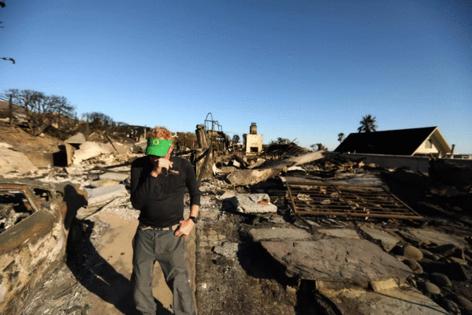After botched fire evacuations, LA County considers disaster registry for elderly, disabled
Published in News & Features
LOS ANGELES — After intense scrutiny of Los Angeles County’s failures in coordinating evacuations during January’s deadly firestorm, officials will look into creating a registry for people with disabilities and other mobility challenges in case of future disasters.
The Board of Supervisors on Tuesday unanimously approved a motion by Supervisors Janice Hahn and Kathryn Barger to study a potential registry following the fire deaths of 17 people in Altadena. The fatalities have highlighted L.A. County’s struggle to plan for the evacuation of elderly and disabled people.
A Times analysis found that the median age of those killed was 77, and at least a third of them suffered impairments that could affect their mobility. Times reporting revealed that west Altadena did not get official evacuation alerts until nearly nine hours after the Eaton fire started.
The Times also reported last week that L.A. County failed to follow the recommendations of the California Governor’s Office of Emergency Services, which said the county must do more to “adequately address” the emergency planning and evacuation needs of its most vulnerable residents. Those recommendations were given to the county less than 16 months before the firestorm.
“When the next disaster hits, we need to be better prepared to evacuate people who cannot evacuate themselves,” Hahn said in a statement. “In an emergency, our first responders should know who our most vulnerable residents are, where they are, and how to reach them when minutes matter and lives are on the line.”
Barger, who represents Altadena, described the motion as a “critical step toward strengthening our preparedness and response efforts.”
“It is devastating to learn that the average age of the 17 lives lost in the Eaton fire was 77 — a tragic reminder of the urgent need to safeguard seniors and people with disabilities during emergency evacuations,” Barger said in a statement. “We have a duty to ensure no one is left behind.”
Anthony Mitchell Jr., whose father and brother died in the fire, said he supported the creation of a registry.
His father, Anthony Mitchell Sr., was an amputee in his 60s, while his brother, Justin Mitchell, suffered from cerebral palsy.
“It would have saved my father,” Anthony Mitchell Jr. said. “It would have saved all of them people there. A lot of people they literally forgot about.”
Before Mitchell Sr. died, he reassured family members that someone was coming to rescue him.
“They trusted in the system,” Mitchell Jr. said. “And the system let them down.”
Mitchell Jr., who lives in Bakersfield and is disabled, said a registry should be set up not just in L.A. County, but across California.
“If a fire starts in one county, it always ends up in other counties,” Mitchell said. “They spread really quickly, so they really need a statewide registry.”
Some disability policy experts are skeptical of the idea that a database of disabled residents will solve the county’s emergency preparedness for people with mobility challenges.
“A registry is a reflex response,” said June Isaacson Kailes, a disability policy consultant in Los Angeles. “Registries don’t work when there are not enough resources to help everyone. They don’t work when the event is a big, catastrophic, disaster.”
A registry — particularly one set up without a detailed emergency evacuation plan — risks offering people unrealistic hope they would be rescued, Isaacson Kailes said.
“It gives people a sense of false security,” she said, citing the case of the Mitchells.
Certainly, government should play a role in coordinating efforts to help people develop their own plan, Isaacson Kailes said. But local officials also have to be transparent about the fact that there are limited resources.
“The best approach is you have a plan to get out,” she said. “It may not be ideal, but you need to work with your neighbors, people very close by, so you help each other save each others lives.”
Mitchell Jr. noted that many disabled people did not have family living nearby. He was about a two-hour drive away from his father and brother. By the time other family members made it to Altadena to rescue them, they were not allowed into the evacuation zone because it was deemed too dangerous. Most of the neighbors had already left.
“It’s at least a starting point,” Mitchell said of a registry. “To sit there and just be like, ‘Oh, we’re not even gonna try’... To me, we’ve got to do something. At least with a registry, you have numbers and addresses of people.”
L.A. County used to maintain a list of vulnerable residents. But officials scrapped the Specific Needs Awareness Planning database nearly a decade ago.
In a 2016 presentation, the county suggested SNAP was too costly, had “low acceptance by the disability community, obsolete software,” and “limited utilization for emergency planning.”
A court-appointed monitor of L.A County’s planning for the disabled agreed. After a 2009 lawsuit, settled in 2012, the monitor argued in a final 2018 settlement report: “L.A. County’s decision to discontinue SNAP was correct.”
Isaacson Kailes said the problem with SNAP was not just that it was expensive to maintain and update. Many people did not register because they did not trust a database or hadn’t heard about it. And those who did register might mistakenly think they would be rescued.
“Do you really have the assets to fulfill the promise?” she asked. “I think the local jurisdictions do have a responsibility to help people evacuate when they cannot do it on their own. But the reality is, when you have an hour or you have four hours, that’s not likely to be enough time to help all the people who may need help.”
T.J. Hill, executive director of the Disability Community Resource Center in Los Angeles, said that, historically, registries have not tended to work in L.A. and other places across the country. But Hill said he applauded the L.A. supervisors for looking to highlight ways to better inform the disability community during a disaster.
“We haven’t looked at the idea of (a) registry in some time,” he said. “New technologies are available and I would be excited to see what discussions come out of that.”
Perhaps, Hill suggested, the focus could shift from a registry to a special earlier notification program for people with disabilities to make sure they had a head-start on evacuating.
Whatever the focus of the study, Hill said he hoped that the Disability Community Resource Center and other members of the disability community would be included.
“I think that having the discussion is always good,” he said. “If this allows us to do a deeper dive into better ways to improve communication with the disability community, then I’m all for it.”
Rather than a registry, Isaacson Kailes suggested the county work with members of the disability community to develop concrete emergency plans to evacuate disabled people in a disaster.
Such plans, she said, should detail “these are the assets we have in place, these are the drivers that have been trained and are available, this is what the response time is, and this is how we’ll do it.”
In addition, local government should provide — and publicize — a dedicated telephone number, not 911, that people with mobility problems can call for help. When people call for help in an emergency, she said, the first thing responders should say is ‘You need a backup plan, we may not get there.’”
Local governments, she said, should work continuously to make sure their plan is realistic — testing it, exercising it, and involving people from the community in problem-solving around it.
“A plan alone is not enough unless you involve people in real, difficult conversations,” Isaacson Kailes said. “We know we will never have enough resources to help everyone. So what should our plan be? Let’s work on it together.”
The motion approved Tuesday directed the county Department of Aging and Disabilities to work with the county’s chief executive, Office of Emergency Management, fire chief and sheriff to look into potentially creating a registry that could help emergency responders locate and assist people with disabilities and the elderly with mobility problems in future emergency evacuations.
The Department of Aging and Disabilities will report back to the board in 120 days after engaging representatives from the disability community to better understand the needs of people with mobility challenges and the elderly. It will also assess the potential legal, technological and privacy challenges of a registry and explore other potential solutions, such as a proactive emergency notification program and improved data-sharing protocols across agencies.
“Given the continuing growth of our older adult population and the number of adults living with disabilities in our county, it is critical that we have an array of options for people to be able to plan for their own well-being and safety in an emergency,” L.A. County Director of Aging and Disabilities Laura Trejo said in a statement.
Los Angeles County Fire Chief Anthony C. Marrone, who publicly called for a registry for the disabled after the fires at a January county board meeting, said he looked forward to collaborating on the feasibility study to examine best practices.
“The unprecedented community conflagrations in January of 2025 highlighted the critical need for and importance of ensuring the safety and well-being of vulnerable populations during emergencies,” Marrone said in a statement.
_____
©2025 Los Angeles Times. Visit at latimes.com. Distributed by Tribune Content Agency, LLC.







Comments